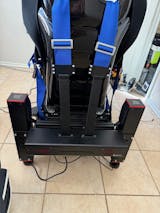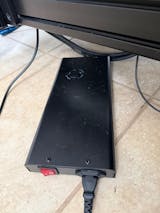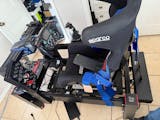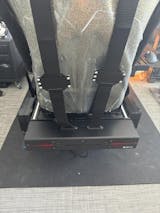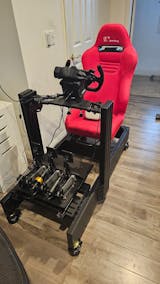Qubic System Seat Belt Tensioner QS-BT1
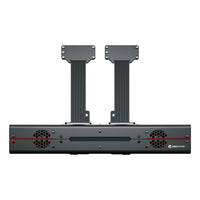


Qubic System Seat Belt Tensioner QS-BT1
Enhancing Car Braking Simulation Experience
QS-BT1 significantly enhances the level of realism, providing you with an unparalleled opportunity to deeply engage in the intricate dynamics of braking.
This innovative device transforms car simulations into an exhilarating and exceptionally authentic experience, setting a new standard for the intensity and authenticity of virtual driving.
Advanced Steering Simulation with Dual Tensioner Tech
The advanced technology of the dual-channel seat belt tensioner enables precise steering motion simulation, creating a dynamic and realistic experience when turning.
Feel subtle reactions on corners and have full control over the steering wheel, just like in a real vehicle.
Vibration to increase immersion
QS-BT1 is an advanced seat belt tensioner equipped with innovative engine vibration technology. With this device, you can literally feel the pulsation of the engine power, adding realism and intensity to their virtual driving experience.
Engine vibrations are precisely tailored to reflect changing road conditions, responding to dynamic accelerations and gear shifts. QS-BT1 allows you to fully immerse themselves in simulated automotive emotions, delivering unforgettable sensations for both racing simulator enthusiasts and those seeking realistic automotive experiences.
Gear Shifting Realism
QS-BT1 goes beyond traditional simulation experiences by introducing the sensation of gear shifting. Through its sophisticated technology, you can distinctly feel the transition between gears as the seat belts respond accordingly to gear changes.
This innovative integration enhances the overall realism of the driving simulation, providing you with tactile feedback that replicates the nuanced dynamics of a real vehicle, making the virtual driving experience even more immersive and engaging.
Compatibility with other devices
QS-BT1 alone is not able to create sensation of forward acceleration and high speed cruising, especially when driving electric vehicle, where engine vibrations are absent and there is only road noise. Even with all effects tuned up, there is a feeling that something is still missing on long straight, in formula car, driving 300 km/h. Fortunately QS-BT1 is compatible with all motion platforms that are powered by Motion Systems technology (QS, PS, HS [1]) and also with our simple to build, fully OpenSource, DIY WindSim which can easily demonstrate you what it is like to drive a car without a roof… in winter… wearing a wig.
Beyond 4 wheels
Being jet fighter pilot is your dream? You want to experience the overload (G) that pilot feels?
QS-BT1, with its astonish 41 kg/90 lbs of sustained pulling force, allows to experience and feel differences between 1G, 2G, 3G or even 9G. Positive G, negative G or both, everything depends on your preferences, sky it the limit, literally. Centrifugal forces, engine vibrations, cannon fire, missiles launch or flares dispose [2] – all of them generate a accurate feedback through QS-BT1 and immerse you deeply into the simulation. The missing factor that binds your body to the seat, the stress you feel on your body during tight maneuvers, making you wonder if you really wish to repeat the same maneuver, are all finally there to make the gap between reality and the simulation once again smaller.
Takes the immersion to a whole new level!
LITTLE DETAILS THAT MATTER
The seat must be selected correctly to match to your body height and width as the position of the seat belt slots is key for realistic force feedback and immersion.
For optimal overall experience, the belt slots should align horizontally with your shoulder level (indicates as “CORRECT HEIGHT“).
Slots above shoulder level (indicated as ‘TOO HIGH’) reduce the realism and enjoyment of the feedback.
Slots below shoulder level (marked as ‘TOO LOW‘) give a downward pull, suitable for flight simulators to mimic downward G-forces, but not ideal for racing simulations.
NO PAIN, NO GAIN
Does NOT apply to here. The seat belts must be aligned in a way that prevents injuries.
Optimal solution is when the seat belts align directly above your shoulders but do not touch your neck (green dashed line).
Slots set too wide can cause unnatural shoulder pull, reducing realism and force feedback accuracy.
Narrowly set slots (inward red arrows) concentrate force uncomfortably on the chest and may restrict movement, diminishing racing simulation immersion and cause injuries.
HIGH-STRESS SIMULATIONS
Professional racing harnesses are built for extreme conditions, offering superior safety and durability over sim racing harnesses. Their robust construction withstands dynamic movements from the QS-BT1 platform, essential for realistic g-force simulation.
Unlike sim racing harnesses, which wear out faster and offer less safety, professional harnesses feature a secure locking mechanism that prevents accidental release during use, yet allows quick disengagement under load for safety. This balance ensures both security and ease of exit in high-stress simulations and easy of use.
READY FOR 24h ENDURANCE RACING
The QS-BT1 provides extremely quiet operation thanks to the technology used as in the QS-220. As a result, with the near-silent performance, QS-BT1 can be used at late hours without disturbing the rest of the household and is perfect for long endurance races where there is a driver changeover – your racing partner will be able to rest or sleep peacefully next to the running QS-BT1 [3].
LOAD IMPACT ON OPERTATING TIME
The graph shows the result of a synthetic load test with a constant pulling force, which allowed a reliable check of the
cooling properties of QS-BT1.
Such force characteristics do not occur during a typical simulation application.




